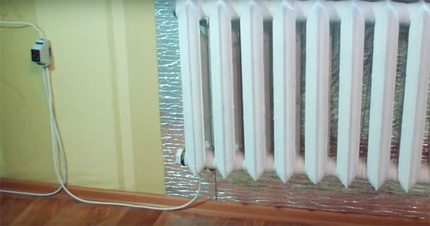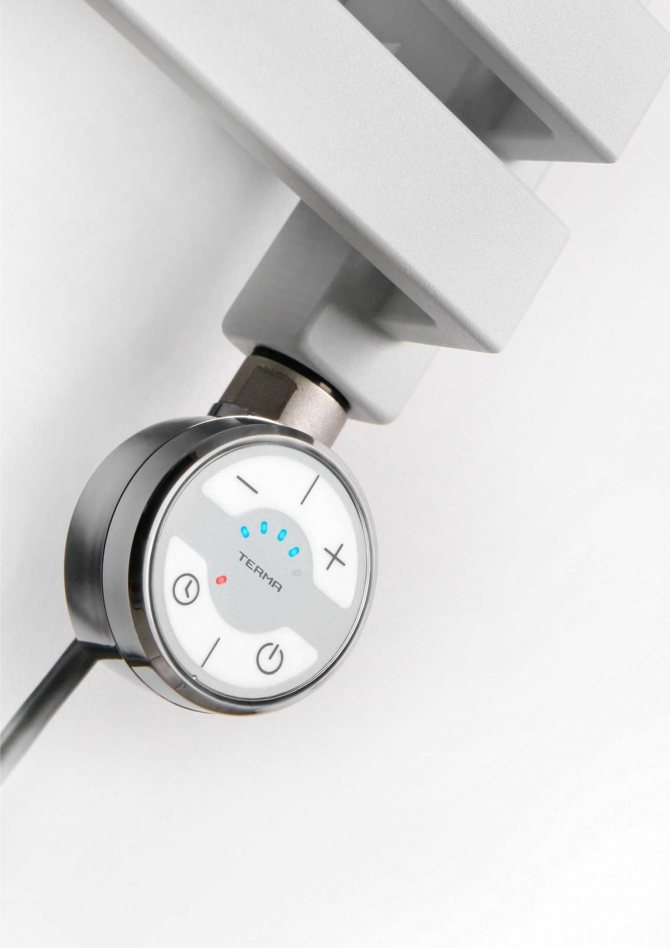The device of heating electric boilers
The operation of the heating elements of boilers is based on the passage of the coolant through a container with installed tubular heating elements. Due to the high resistance of the spiral inside the tube, an increased amount of thermal energy is released when the current flows along the spiral. It also goes into heating the coolant passing through the heating elements.
Automation of heating elements of boilers allows you to control their operation, temperature control and automatic switching on and off.

Radiator electric home heating
Installation diagram of the heating element in the radiator
Before embedding the heating element into the heating system, the parameters of the radiator are needed. The main one is the diameter of the connecting pipe. Currently, manufacturers produce products in two sizes - 1/2 and 3/4 inches. Then a comparative analysis of the heating parameters is carried out before and after the installation of the heating element.
Connecting the heating element to the existing heating
If it will be used as an additional method of heating water, it is necessary to take into account the change in the hydraulic pressure when passing through the radiator. Since the flow diameter of the system will be smaller this month, it is recommended to install a larger pump.
When a radiator is connected to the system, the installation of a heating element for heating the house will be impossible. To do this, either change the wiring diagram to the top, or install a heating element on the top of the battery, which is not recommended by specialists.
Installation is often done in old cast iron batteries. Before carrying out work, you must first check the direction of the thread of the branch pipe (right or left) and also measure its diameter. Then you should adhere to the following scheme:
- Draining the coolant. It is forbidden to install a heating element in a heating radiator if there is water in it;
- Checking the battery level. Even with a small angle of inclination, the likelihood of the formation of air jams is significantly increased;
- Installation of a heating element in the pipe. To seal the holes, you must use the gaskets supplied with the heating element or make them yourself;
- Installation of a block with a thermostat, if there is one in the kit.
An example of installing a heating element in a cast-iron radiator
After that it is necessary to fill the system with water. With the help of the installed Mayevsky crane, possible air jams are removed. Before switching on, for safety reasons, a possible heating coil-battery circuit is checked using a tester. If it is, you need to dismantle the heating element and install it again, improving the sealing.
Radiator electric heating
When organizing self-made heating on heating elements, installation of the pipeline is not necessary. A heating element must be installed on each radiator. At the same time, it is possible to mount models of different power, depending on the thermal regime in a particular room of the house. The advantages of such a system are as follows:
- Saving on the purchase of materials and reducing the labor intensity of installation work;
- If a heating element with a thermostat for heating and a temperature sensor connected to it is used, the room heating degree will be adjusted automatically;
- Minimum heating inertia of the system.
But all these positive qualities can be overridden by the total cost of service.Therefore, before heating with electric tendens, you need to calculate not only the cost of purchasing materials and components, but also the subsequent costs of electricity. Only then should a heating system of this type be introduced.
It is recommended to purchase factory radiators with installed heating elements. The efficiency of their work is higher than that of home-made ones, since a special oil is used as a coolant. Even with the heating element turned off, it will give off heat to the room for some time.
Disadvantages of heating elements of boilers
Indirect heating of the coolant in the heating element tank of the boiler, significantly increases the heating time. It takes more than 10-15 minutes to warm up such a boiler.
This is a subjective drawback, which is perfectly compensated by the safety and clean operation of the heating elements of the boilers.
However, due to indirect heating, 10-15% of the heat released by heating elements is lost even at the heating stage. This negatively affects the efficiency of such boilers.
The weak point of the heating elements of the boiler are the heating elements themselves. Being constantly in an aggressive environment, they rust, corrode and salt deposits. A simple metal heater will require replacement in 5-6 years.
Cons and pros of a radiator heating element
Tubular type electric heaters make it possible to assemble a practical and rather effective heating system for the main or additional heating.
The advantages of devices include:
- Extreme ease of installation... Every novice master will cope with this work.
- Low cost of the device, however, we mean the price of one heating element, without additional equipment.
- Greater reliability compared to oil coolers. In addition, batteries with heating elements are repairable. If the equipment fails, it will be enough to replace the heater.
- Availability of additional options and functionality.
- Automatic control capability heating system, but this will require additional equipment.
We have listed the main advantages of radiator heating elements, consider their significant disadvantages. There are quite a few of them. First of all, these are impressive operating costs due to the high cost of electricity. They can be reduced by fully automating the control of the heating system.
In this case, the heating elements will be switched on only after the temperature in the room has dropped to a certain minimum value. And turn off when it reaches a temperature defined as comfortable. Working in this mode is as economical as possible.


The simplest design radiator heating elements are not equipped with automatic control. To automate such a system, you will need to purchase additional equipment.
However, automation equipment will require financial investments. If we consider the purchase of a heating element complete with a radiator and automation, the cost of such a kit will be much higher than the price of an electric convector or an oil radiator.
But at the same time, the latter are in no way inferior in terms of the level of comfort provided, and in some ways even surpass radiators with heating elements. For example, the latter require a permanent installation, while electric convectors and oil coolers are more mobile and compact.
In addition, like any other electrical device, heating elements generate a magnetic field during operation. Its danger to the body has not been proven, as well as safety. Therefore, it is worth attributing the presence of such a field to the negative qualities of devices, because they are mounted in radiators, that is, they are in close proximity to people.
In other heating systems powered by electricity, this disadvantage is to some extent leveled. For example, electric boilers are located in non-residential premises, where the presence of a person is short-lived.
One of the most significant disadvantages of radiator heating elements is their relatively low efficiency. If we compare it with the efficiency of traditional systems working with a liquid heat carrier, it will be much lower.
This is due to the fact that in the first case, the coolant moves at a fairly high speed. Thanks to this, the radiator heats up quickly and completely.


To increase the heat transfer of radiators equipped with heating elements, you can cover the wall, and which the device is fixed to, with a reflective foil screen. Heat radiation will only move into the room
The operation of the heating element is not able to provide such a high speed. As a result, the heating of the battery case will be uneven. At the bottom, the temperature will be much higher than at the top.
Considering that for safety reasons, the battery should not be heated above + 70 ° C, such a temperature will be present only in the lower part of the radiator, where the heating element is located. Therefore, in order to prevent overheating of the equipment, it will be necessary to reduce its power by about a third.
Types of heating elements of heaters
However, in addition to metal tubular heating elements, there are more expensive and durable counterparts. Today on sale you can find electric boilers with the following types of heating elements:
- Metal alloy with cupronickel and nichrome;
- Heating elements made of ceramics;
- Heating elements made of composite materials.
The most expensive ceramic heating element has the longest service life.


Boiler heating element example
Let's look at an example of a popular manufacturer of heating elements for boilers, the Teplotekh plant, boilers of the EVP brand (electric water heaters).
Boiler EVP-18M, 380V
This boiler has a power of 18 kW, which is enough to heat a house with an area of 160 meters. The boiler costs 7800-7900 rubles. The high power of the boiler provides the possibility of a three-phase supply. However, this complicates its connection in the country houses of individuals.
- This boiler has a large volume of a heating flask, which allows uniform heating of the system coolant without possible overheating.
- The boiler has a stepwise power switching. The switching is controlled by three keys from the control indications of the included power.
- The temperature of the coolant is monitored by a temperature sensor.
- It is possible to connect a room temperature sensor and limit the heating temperature of the premises.


The boiler thermostat regulates the temperature of the heating medium in the range from 0 to 85 ° C.
© Obotoplenii.ru
Heating elements in the heating system
Different types of heating elements
Electric heating appliances are often used to heat rooms. One of the varieties of such heating heating elements is tubular electric heaters. What is this widespread device? TEN is a device for medium-temperature heating of the heat carrier. Structurally, it is a thin-walled metal tube with a spiral placed inside, which is made of a high-resistance material - nichrome. The ends of the spiral come out in the form of a contact rod, are sealed and serve for connection to the mains.
The tube itself is made of steel, carbon or stainless. After being placed inside and centering the spiral, the tube is filled with a special coolant - periclase and sealed. Being under high pressure, the periclase fixes the spiral along the axis and after that the heating element is bent and given the required shape, depending on the model.
Regardless of how the heating elements will be used - in a solid fuel heating boiler or in an infrared heater - there are certain rules for the installation and operation of heaters of this type. At the same time, electric heating elements can be used for a variety of purposes: for heating the garage. home heating, for installation in heating boilers or radiators.Let's consider in more detail the ways of using heating elements for heating.
Tubular electric heater device

















